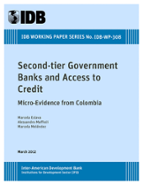Second-tier Government Banks and Access to Credit: Micro-Evidence from Colombia
Date
Mar 2012
Government-owned development banks have often been justified by the need to respond to financial market imperfections that hinder the establishment and growth of promising businesses, and as a result, stifle economic development more generally. However, evidence on the effectiveness of these banks in mitigating financial constraints is still lacking. To fill this gap, this paper analyzes the impact of Bancoldex, Colombia's publicly owned development bank, on access to credit. It uses a unique dataset that contains key characteristics of all loans issued to businesses in Colombia, including the financial intermediary through which the loan was granted and whether the loan was funded with Bancoldex resources. The paper assesses effects on access to credit by comparing Bancoldex loans to loans from other sources and study the impact of receiving credit from Bancoldex on a firm's subsequent credit history. To address concerns about selection bias, it uses a combination of models that control for fixed effects and matching techniques. The findings herein show that credit relationships involving Bancoldex funding are characterized by lower interest rates, larger loans, and loans with longer terms. These characteristics translated into lower average interest rates and larger average loans for firms that used Bancoldex credit. Average loans of Bancoldex' beneficiaries also exhibit longer terms, although this effect can take two years to materialize. Finally, the findings show evidence of a demonstration effect of Bancoldex: beneficiary firms that have access Bancoldex credit are able to significantly expand the number of intermediaries with whom they have credit relationships.




